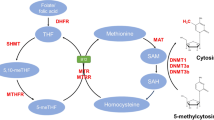Abstract
Periconceptional folic acid supplementation reduces the risk of having a child with spina bifida. N-acetyltransferase 1 (NAT1) participates in the catabolism of folates and the acetylation of aromatic and heterocyclic amines. Hence, functional polymorphisms in NAT1, the gene encoding NAT1, could influence the risk of spina bifida via either folate catabolism or acetylation of exogenous agents. Individuals with spina bifida and their parents were genotyped for six NAT1 single nucleotide polymorphisms (SNPs) for which the less common allele is associated with reduced or absent enzyme activity (i.e. 97C>T, 190C>T, 559C>T/560G>A, 640T>G and 752A>T). In addition, a “composite” NAT1 genotype was defined as a function of the genotyped SNPs. Descriptive analyses of the SNPs and of the composite genotype indicated that heterozygous parents were more likely to transmit the common allele than the rare allele to their affected offspring. Furthermore, matings of mothers homozygous for the common allele and heterozygous fathers were more common than the reciprocal matings. Log-linear analyses confirmed that both the maternal (P = 0.008) and offspring (P = 0.003) composite NAT1 genotypes were significantly related to the risk of spina bifida. NAT1 variants that reduce or abolish enzyme activity appear to protect against spina bifida, and to exert their influence via both the maternal and the offspring genotypes. These associations may be attributable to a decrease in either folate catabolism or the conversion of exogenous agents to teratogenic derivatives in women and/or developing embryos with a NAT1 genotype that includes a loss of function allele relative to those who do not.
Similar content being viewed by others
References
Berry RJ, Li Z (2002) Folic acid alone prevents neural tube defects: evidence from the China study. Epidemiology 13:114–116
Butcher NJ, Arulpragasam A, Goh HL, Davey T, Minchin RF (2005) Genomic organization of human arylamine N-acetyltransferase Type I reveals alternative promoters that generate different 5′-UTR splice variants and altered translational activities. Biochem J 387:119–127
Czeizel AE, Dudas I (1992) Prevention of the first occurrence of neural-tube defects by periconceptional vitamin supplementation. N Engl J Med 327:1832–1835
Dupret JM, Dairou J, Atmane N, Rodrigues-Lima F (2005) Inactivation of human arylamine N-acetyltransferase 1 by hydrogen peroxide and peroxynitrate. Methods Enzymol 400:215–229
Hein DW, Doll MA, Fretland AJ, Leff MA, Webb SJ, Xiao GH, Devanaboyina US, Nangju NA, Feng Y (2000) Molecular genetics and epidemiology of the NAT1 and NAT2 acetylation polymorphisms. Cancer Epidemiol Biomarkers Prev 9:29–42
Hein DW (2002) Molecular genetics and function of NAT1 and NAT2: role in aromatic amine metabolism and carcinogenesis. Mutat Res 506–507:65–77
Jensen LE, Hoess K, Whitehead AS, Mitchell LE (2005) The NAT1 C1095A polymorphism, maternal multivitamin use and smoking, and the risk of spina bifida. Birth Defects Research (Part A) 73:512–516
Minchin RF (1995) Acetylation of p-aminobenzoylglutamate, a folic acid catabolite, by recombinant human arylamine N-acetyltransferase and U937 cells. Biochem J 307:1–3
Mitchell LE, Adzick NS, Melchionne J, Pasquariello PS, Sutton LN, Whitehead AS (2004) Spina bifida. Lancet 364:1885–1895
Mitchell MK, Futscher BW, McQueen CA (1999) Developmental expression of N-acetyltransferases in C57BL/6 mice. Drug Metab Dispos 27:261–264
MRC (1991) Prevention of neural tube defects. Lancet 338:131–137
Payton M, Smelt V, Upton A, Sim E (1999) A method for genotyping murine arylamine N-acetyltransferase type 2 (NAT2): a gene expressed in preimplantation embryonic offspring stem cells encoding an enzyme acetylating the folate catabolite p-aminobenzoylglutamate. Biochem Pharmacol 58:779–785
Smelt VA, Upton A, Adjaye J, Payton MA, Boukouvala S, Johnson N, Mardon HJ, Sim E (2000) Expression of arylamine N-acetyltransferases in pre-term placentas and in human pre-implantation embryos. Hum Mol Genet 9:1101–1107
Stanley LA, Copp AJ, Pope J, Rolls S, Smelt VH, Sim E (1998) Immunochemical detection of arylamine N-acetyltransferase during mouse embryonic offspring development and in adult mouse brain. Teratology 58:174–182
Sugamori KS, Wong S, Gaedigk A, Yu V, Abramovici H, Rozmahel R, Grant DM (2003) Generation and functional characterization of arylamine N-acetyltransferase Nat1/Nat2 double-knockout mice. Mol Pharmacol 64:170–179
Ward A, Summers MJ, Sim E (1995) Purification of recombinant human N-acetyltransferase type 1 (NAT1) expressed in E. coli and characterization of its potential role in folate metabolism. Biochem Pharmacol 49:1759–1767
Weinberg CR, Wilcox AJ, Lie RT (1998) A log-linear approach to case-parent-triad data: assesing the effects of disease genes that act either directly or through maternal effects and that may be subject to parental imprinting. Am J Hum Genet 62:969–978
Wilcox AJ, Weinberg CR, Lie RT (1998) Distinquishing the effects of maternal and offspring genes through studies of “case-parent triads”. Am J Epidemiol 148:893–901
Acknowledgments
This study was supported by grants from the National Institutes of Health (HD39195; HD39081), the Ethel Brown Foerderer Fund for Excellence and the General Clinical Research Center (M01-RR00240) of The Childrens Hospital of Philadelphia. The authors are grateful to their colleagues in The Spina Bifida Program (Dr. P. Pasquariello and J. Melchionni) and The Center for Fetal Diagnosis and Therapy (Dr. N.S. Adzick, Dr. M.P. Johnson, Dr. R.D. Wilson, L. Howell, S. Miesnik, M. Oxman and S. Kasperski) at The Children’s Hospital of Philadelphia, and in the Spinal Dysfunction Clinic at The A.I. duPont Hospital for Children (Dr. M. McManus and R. Gleeson), to Gillian Wallace for technical assistance, and to all of the families that have enrolled in this study.
Author information
Authors and Affiliations
Corresponding author
Additional information
The sequence reported in this paper has been submitted to GenBank under accession number AY730684.
Rights and permissions
About this article
Cite this article
Jensen, L.E., Hoess, K., Mitchell, L.E. et al. Loss of function polymorphisms in NAT1 protect against spina bifida. Hum Genet 120, 52–57 (2006). https://doi.org/10.1007/s00439-006-0181-6
Received:
Accepted:
Published:
Issue Date:
DOI: https://doi.org/10.1007/s00439-006-0181-6




